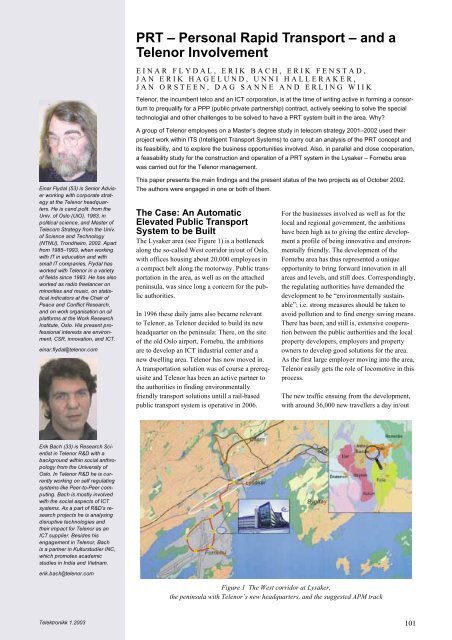Intelligent Transport Systems - Telenor
Intelligent Transport Systems - Telenor
Intelligent Transport Systems - Telenor
You also want an ePaper? Increase the reach of your titles
YUMPU automatically turns print PDFs into web optimized ePapers that Google loves.
Einar Flydal (53) is Senior Adviser<br />
working with corporate strategy<br />
at the <strong>Telenor</strong> headquarters.<br />
He is cand.polit. from the<br />
Univ. of Oslo (UiO), 1983, in<br />
political science, and Master of<br />
Telecom Strategy from the Univ.<br />
of Science and Technology<br />
(NTNU), Trondheim, 2002. Apart<br />
from 1985–1993, when working<br />
with IT in education and with<br />
small IT companies, Flydal has<br />
worked with <strong>Telenor</strong> in a variety<br />
of fields since 1983. He has also<br />
worked as radio freelancer on<br />
minorities and music, on statistical<br />
indicators at the Chair of<br />
Peace and Conflict Research,<br />
and on work organisation on oil<br />
platforms at the Work Research<br />
Institute, Oslo. His present professional<br />
interests are environment,<br />
CSR, innovation, and ICT.<br />
einar.flydal@telenor.com<br />
Erik Bach (33) is Research Scientist<br />
in <strong>Telenor</strong> R&D with a<br />
background within social anthropology<br />
from the University of<br />
Oslo. In <strong>Telenor</strong> R&D he is currently<br />
working on self regulating<br />
systems like Peer-to-Peer computing.<br />
Bach is mostly involved<br />
with the social aspects of ICT<br />
systems. As a part of R&D’s research<br />
projects he is analysing<br />
disruptive technologies and<br />
their impact for <strong>Telenor</strong> as an<br />
ICT supplier. Besides his<br />
engagement in <strong>Telenor</strong>, Bach<br />
is a partner in Kulturstudier INC,<br />
which promotes academic<br />
studies in India and Vietnam.<br />
erik.bach@telenor.com<br />
Telektronikk 1.2003<br />
PRT – Personal Rapid <strong>Transport</strong> – and a<br />
<strong>Telenor</strong> Involvement<br />
EINAR FLYDAL, ERIK BACH, ERIK FENSTAD,<br />
JAN ERIK HAGELUND, UNNI HALLERAKER,<br />
JAN ORSTEEN, DAG SANNE AND ERLING WIIK<br />
<strong>Telenor</strong>, the incumbent telco and an ICT corporation, is at the time of writing active in forming a consortium<br />
to prequalify for a PPP (public private partnership) contract, actively seeking to solve the special<br />
technologial and other challenges to be solved to have a PRT system built in the area. Why?<br />
A group of <strong>Telenor</strong> employees on a Master’s degree study in telecom strategy 2001–2002 used their<br />
project work within ITS (<strong>Intelligent</strong> <strong>Transport</strong> <strong>Systems</strong>) to carry out an analysis of the PRT concept and<br />
its feasibility, and to explore the business opportunities involved. Also, in parallel and close cooperation,<br />
a feasability study for the construction and operation of a PRT system in the Lysaker – Fornebu area<br />
was carried out for the <strong>Telenor</strong> management.<br />
This paper presents the main findings and the present status of the two projects as of October 2002.<br />
The authors were engaged in one or both of them.<br />
The Case: An Automatic<br />
Elevated Public <strong>Transport</strong><br />
System to be Built<br />
The Lysaker area (see Figure 1) is a bottleneck<br />
along the so-called West corridor in/out of Oslo,<br />
with offices housing about 20,000 employees in<br />
a compact belt along the motorway. Public transportation<br />
in the area, as well as on the attached<br />
peninsula, was since long a concern for the public<br />
authorities.<br />
In 1996 these daily jams also became relevant<br />
to <strong>Telenor</strong>, as <strong>Telenor</strong> decided to build its new<br />
headquarter on the peninsula: There, on the site<br />
of the old Oslo airport, Fornebu, the ambitions<br />
are to develop an ICT industrial center and a<br />
new dwelling area. <strong>Telenor</strong> has now moved in.<br />
A transportation solution was of course a prerequisite<br />
and <strong>Telenor</strong> has been an active partner to<br />
the authorities in finding environmentally<br />
friendly transport solutions untill a rail-based<br />
public transport system is operative in 2006.<br />
For the businesses involved as well as for the<br />
local and regional government, the ambitions<br />
have been high as to giving the entire development<br />
a profile of being innovative and environmentally<br />
friendly. The development of the<br />
Fornebu area has thus represented a unique<br />
opportunity to bring forward innovation in all<br />
areas and levels, and still does. Correspondingly,<br />
the regulating authorities have demanded the<br />
development to be “environmentally sustainable”;<br />
i.e. strong measures should be taken to<br />
avoid pollution and to find energy saving means.<br />
There has been, and still is, extensive cooperation<br />
between the public authorities and the local<br />
property developers, employers and property<br />
owners to develop good solutions for the area.<br />
As the first large employer moving into the area,<br />
<strong>Telenor</strong> easily gets the role of locomotive in this<br />
process.<br />
The new traffic ensuing from the development,<br />
with around 36,000 new travellers a day in/out<br />
Figure 1 The West corridor at Lysaker,<br />
the peninsula with <strong>Telenor</strong>’s new headquarters, and the suggested APM track<br />
101
















